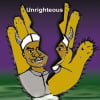Bhadrapad Krushna Shashthi, Kaliyug Varsha 5112
As the Lucknow bench of the Allahabad High Court prepares to announce its verdict on Ayodhya, TNSE looks at the genesis of a problem that culminated in the destruction of the Babri Masjid:
How did the dispute begin?
The roots of the dispute date back to 1528 when Babur, the first Mughal emperor, built the Babri Masjid on the site. It is said the site marks the exact spot where Lord Ram was born and that there had already been a temple there.
When did it become a religious issue?
In 1853, the Nirmohi Akhara claimed the structure, contending that there had been a temple on the site, destroyed in Babur’s time.
In 1859, the British built a fence, allowing the inner court to be used by Muslims and the outer by Hindus. In 1883 an attempt was made to build a temple there, halted by the administration.
When was the first case filed, and by whom?
In 1885, mahant Raghubir Das filed a suit asking for permission to build a temple. The suit was dismissed in 1886, as was the appeal.
When did the next stage of trouble begin?
In 1949, idols of Lord Ram appeared inside the mosque, allegedly placed there by Hindus. The Muslims protested, and both parties filed civil suits. The government proclaimed the premises a disputed area and locked the gates. The locks were removed in 1986 and Shilyanas (consecration of the idols) for the temple performed in 1989.
What is the Ayodhya title suit?
The suit is about whether there was a temple at the site prior to 1528. The first title suit was filed in 1950 by Gopal Singh Visharad, seeking permission for pooja at the site. The second was filed by Paramhans Tamchandra Das, also in 1950, seeking the same injunction. It was later withdrawn. The third suit was filed in 1959 by the Nirmohi Akhara demanding possession of the disputed site.
The fourth was filed in 1961 by the UP Sunni Central Board of Waqfs for declaration and possession of the site. The fifth was moved on July 1, 1989 in the name of Bhagwan Shree Ram Lalla Virajman also for declaration and possession. The four title suits remained pending in the Faizabad civil court and in 1989, on an application by then Advocate General of UP, were transferred to the Allahabad High Court.
Is there evidence for the temple?
Excavations by the Archaeological Survey of India in 1970, 1992 and 2003 in and around the disputed site have indicated a large Hindu complex existed on the site. Its 2003 report mentions “distinctive features associated with… temples of north India”.
Source: Express Buzz
Also See
 |
Hindu Genocide in Kashmir & Bangladesh
Online photo exhibition of Hindu genocide and temples destruction in Kashmir by local Muslims. Series of exhibitions being arranged. |
 |
Grave sins of Congress are driving India to doom!
Highest sins of the Congress which is taking the country to Hell and of all political parties who are doing nothing about it but just letting that happen ! |




